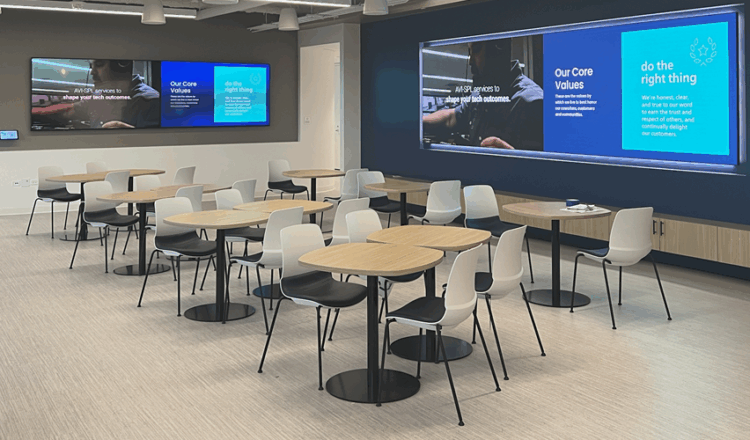Digital Signage Advertising ROI
Unlocking New Revenue in High-Traffic Transit Locations
Transportation is the backbone of our global economy, and the health of the industry is pivotal to how companies do business, communities connect, and how people move, experience, and engage with the world around them. Despite its resiliency, the industry is at an inflection point fueled by the rapid progression of technology.
With over 1.4 billion international tourists recorded in 2024 and the global transportation services market nearing almost $8 billion in revenue, transportation hubs are poised for digital transformation. Decision-makers have a clear opportunity to unlock new revenue streams by embracing digital innovation. Digital signage is at the center of this shift, impacting everything from the traveler experience to annual revenues of transportation hubs.
Revenue Opportunities Through Strategic Digital Signage
As the industry gains momentum, the path to financial stability for airports, rail stations, and smart city transportation services is evolving. Maximizing commercial revenue through transit advertising, retail partnerships, and upselling is now essential. And with decision-makers needing to maximize ROI for technology investments, the stakes are high. Let’s examine how digital signage unlocks revenue in high-traffic transit locations.
Monetization is Key
One of digital signage’s greatest strengths is its ability to capture attention. In fact, digital signage delivers a 47.7% increase in effectiveness when it comes to brand awareness. In an industry where commercial revenue is becoming increasingly important, monetizing existing and new opportunities within transportation hubs is a great place to start.
For travelers who have long layovers or arrive early, capturing their attention with real-time and targeted promotions can influence purchasing decisions. Large advertising displays or kiosks near convenience stores or retail locations that run real-time promos based on the time of day is a good way of enticing travelers, especially when 67% of consumers purchase based on digital signage.
Conversely, travelers can also be in a rush, requiring every aspect of the experience to be seamless. Their time and attention are their biggest assets. That means when they go to a restaurant, bar, or retail location, purchasing should be easy and direct. Deploying digital menu boards where travelers can quickly see the menu, order, and grab their pre-travel meal is appealing and often attracts more business due to simplicity.
Increasing Value-Added Service Recognition
Most travelers encounter some form of digital screen in their transit. Whether it’s walking past an airline lounge entrance display, checking luggage at an interactive kiosk, or seeing a video wall with arrivals and departures, signage is everywhere. This existing visibility presents an opportunity to promote value-added transportation services like travel class upgrades, paid memberships, and Wi-Fi access. By leveraging and expanding these touchpoints, transit operators can significantly boost advertising ROI and drive greater passenger engagement.
BrightSign media players and BrightSignOS™ provide unparalleled content control and management, meaning customers can strategically deploy interactive visuals during times where travelers are already engaging with screens. This allows for timely, targeted messaging around value-added services, increasing convenience for the traveler. Even if in that moment travelers don’t purchase these services, digital signage has a recall rate of 83%, meaning they’re likely to remember the message and engage later.
Strategic use of advertising screens, like multi-screen displays near entrances or check-in lines, also increases recognition of new services offered by transportation hubs. Whether it’s the introduction of a new airline or rail provider, the launch of expanded routes, or the rollout of updated membership benefits, digital signage ensures these offerings get seen. This makes it a powerful investment that drives revenue and awareness in ways traditional advertising methods simply cannot match.
An Advertiser’s Dream
There are very few places that mirror the audience of transportation providers. With high-traffic transit hubs attracting astounding numbers of travelers that span a broad range of demographics, they become increasingly desirable to outside advertisers. Because digital signage is multifaceted and can change and display content instantly, it becomes a canvas for brands to reach differing audiences and bring awareness to their services in real time.
When travelers are interacting with the mini display in front of their seat, or waiting to board and observing surrounding displays, advertisers — especially global brands — can tell their stories without disruption. Signage also serves as a vehicle for brands to tell timely stories during periods of heavy travel like national and cultural holidays. Advertisers can appear more authentic to travelers by connecting their story to relevant happenings.

Maximize Revenue Today
For transit businesses to succeed in the digital age, their offerings must adapt and leverage technology that delivers clear ROI.
Added revenue from digital signage can increase the rate of business expansion, offset lost revenue during slower periods of travel, and help fund predictive and spontaneous maintenance. When implemented correctly, transportation digital signage enhances the traveler experience by delivering engaging content that feels seamless rather than intrusive.
Explore Digital Signage Solutions for Transportation
See how top transportation providers and advertisers are using BrightSign to create modern, reliable travel experiences.


